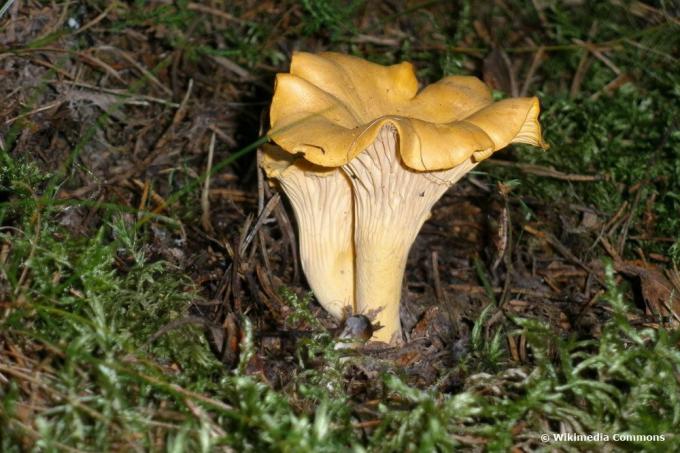
table of contents
- The main season is in summer
- Influencing factor meteorological singularity
- Finding Premium Mushrooms - Tips & Tricks
Chanterelles are demanding and don't grow in every season. Anyone who is familiar with the harvest time leaves the forest with a bulging basket. This guide will familiarize you with all the information about the chanterelle season.
The main season is in summer
Golden yellow chanterelles awaken the passion for collecting among enthusiastic friends of freshly harvested mushroom dishes. In order to indulge in the enjoyable hobby, the time window is only open to a limited extent. The popular Edible mushrooms consistently refuse to grow under controlled conditions of commercial cultivation, like mushrooms available year-round. The only option for a bulging basket with crunchy, dewy chanterelles is a foray through the forest. The date has to be chosen wisely, because the yolk yellow natural treasures flourish according to the motto: If you want to be accepted, do yourself seldom. Because nature is reluctant to be forced into a tight schedule, the following information is based on empirical values:
- Main season: late June / early July to mid / late October
- Early start of the harvest season: depending on the weather, from mid / end of May
- Extended harvest time: due to weather conditions until mid / end of November

The climate has the final say about the beginning and the end of the collection period. You can find out which three weather phenomena explicitly affect the chanterelle season in the following sections.
Influencing factor meteorological singularity
Three weather phenomena are directly related to the harvest time of chanterelles. We are talking about meteorological singularities that occur or do not occur at a certain time of the year for no apparent reason. If the ice saints fail, the time window for the season opens parallel to the start of the planting time in the garden. While October spoils us with a splendid Indian summer, the collection time extends well into autumn. Sometimes the cold sheep mixes in and excites expectant mushroom pickers for a particularly long time.
An old peasant rule is closely related to the commemoration days of five saints between the 11th and 15. May. As a result, stable, frost-free weather conditions can only be expected from the 15th May, when the last ice saint has said goodbye to cold Sophie. In the course of global warming, mild temperatures often already prevail from the beginning of May, so that there can be no longer any question of ice saints. Then golden yellow chanterelles will smile at you from the mulch of the forest as early as mid-May.
With bright sunshine and high summer temperatures, Indian summer activates the growth of chanterelles. Chanterelles cannot be missed out on imperial weather well into October and continue to grow cheerfully. Thanks to the welcome extension of the season, the delicate mushrooms will be on the local menu until All Saints' Day.
The cold from the sheep is a disruptive factor for a long harvest time. With rough weather, the phenomenon causes heat-loving chanterelles to shiver, which then postpone their start of growth until the general conditions improve. The meteorological singularity sometimes occurs around the 11th June with a winter cold snap. In the past few years, however, the climatic evil was seldom to be complained about.

Note: Did you know that there is a legal limit for collecting chanterelles? The coveted edible mushrooms are subject to the Federal Species Protection Ordinance. According to Section 1, Section 2, chanterelles may only be taken from nature in small quantities for personal use. Depending on the region, the permitted amounts are between one and two kilograms per mushroom picker.
Finding Premium Mushrooms - Tips & Tricks
In humid and warm weather, chanterelles put on the turbo and flood the forest floor with promising mushroom hats. Hot summer weather with a tendency to thunderstorms attracts mushroom pickers in droves to the forest for profitable collecting tours. Damp heat lets the mushrooms literally shoot out of the ground. Those who are familiar with the special preferences of chanterelles can find the most beautiful specimens. This is how it works:
- Typical occurrences: near the roots of spruce, fir, pine, oak and beech
- Promising locations: light, east-facing slopes with young, regrowing red beeches
- frequent sites: loose soil, covered with the leaves of old beeches
- best time of day: early in the morning in warm and humid weather
- keep looking: a chanterelle seldom grows alone
- Pay attention to the risk of confusion: check each chanterelle individually

A finger test reveals poisonous doppelgangers of chanterelles. All edible species of chanterelle thrive as caplets with firmly fused ridges under the hat that run down the stalk. False chanterelle (Hygrophoropsis aurantiaca) and poisonous olive tree funnel (Omphalotus olearius), on the other hand, are lamellar or leaf mushrooms. Narrow leaves under the hat can be loosened and moved with light finger pressure.
